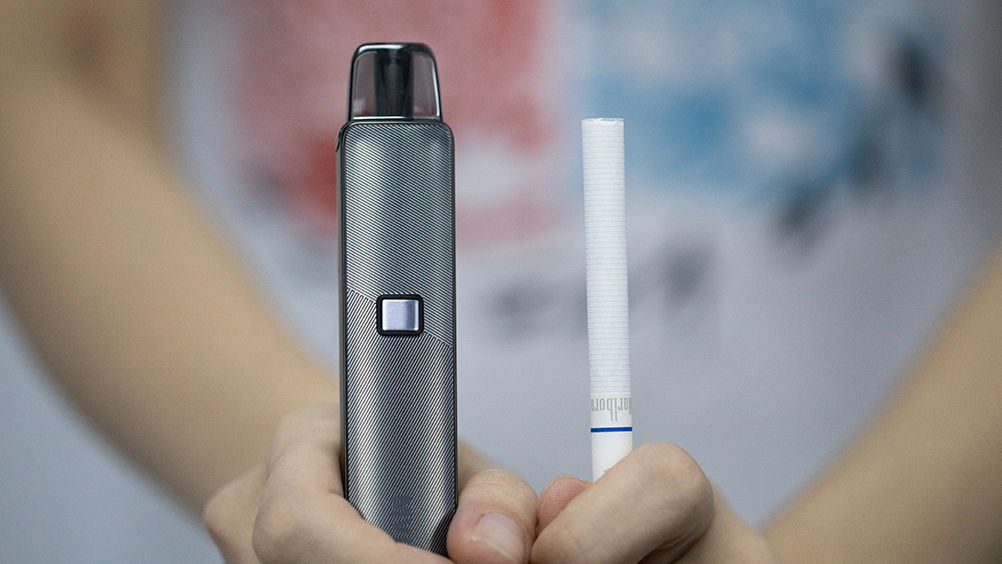Vaping is a complicated topic, especially for transitioning smokers. Naturally, new vapers often head online to ask questions about the health risks, costs, and effectiveness of vaping products.
Unfortunately, some commonly perpetuated myths about vaping can be off-putting and high levels of misinformation may even be preventing smokers from making the switch.
In this post, we’re going to break down some common vaping myths, with the goal of helping transitioning smokers make informed decisions.
Myth: vaping devices use nicotine, so they’re just as harmful as smoking
We’ve known about the incredible harm cigarettes cause for decades. By association, many people assume that nicotine must be the root cause. Although nicotine is highly addictive, evidence shows that it poses minimal risk of harm to health.
In reality, the thousands of chemicals in cigarette smoke cause almost all of the harm of combustible tobacco. No combustion takes place in a vaping device and as a result, the vapour does not contain things like tar and carbon monoxide.
This does not mean that vaping is entirely risk-free, but Public Health England (PHE) continues to stand by its assertion that vaping is approximately 95% less harmful than smoking.

Myth: second-hand vapour is harmful
Cigarette smoke is so harmful that it damages the health of the smoker and others in their vicinity. This effect is even more pronounced in enclosed spaces and is often referred to as second-hand smoke. The harm caused by second-hand smoke has led many governments to ban smoking in shared areas such as bars, clubs and places of work.
Since the vapour emitted from vaping devices is often more visible than the smoke from cigarettes, some non-vapers have become concerned about its potential effects. Fortunately, PHE’s 2018 evidence review of e-cigarettes found that there had been no identified health risks of passive vaping to bystanders.
Although this is very encouraging for vapers, we still have a responsibility to be respectful of our surroundings. You should never use a vaping device in a place where it would not be acceptable to smoke.

Myth: vaping doesn’t help people quit smoking
Quitting smoking is very challenging, particularly if you have been smoking for a long time. There are many products designed to aid in smoking cessation, including nicotine patches, gums, lozenges and sprays.
Vaping is still a relatively new concept, so naturally, people are sceptical about whether it can help them cut down or entirely quit smoking. One common misconception is that vaping does not help people quit smoking, and may lead to increased smoking.
There is a growing body of evidence that not only suggests vaping can help smokers quit but that it might be one of the most effective alternatives.
A major UK National Institute for Health Research (NIHR) trial from 2019 found that vaping was twice as effective at helping participants quit smoking, compared with a combination of traditional nicotine replacement therapies.
It’s important to note that all participants were provided with behavioural support, so this will be a crucial element of any attempt to quit smoking.
According to PHE’s 2021 evidence update summary: “As suggested in previous evidence reviews, combining vaping products (the most popular source of support used by people making a quit attempt in the general population), with stop smoking service support (the most effective type of support), should be an option available to all people who want to quit smoking.”
If you are new to vaping and would like to learn more about how to use your device properly, check out our beginner’s guide to vaping.

Myth: vaping is a gateway to smoking
We know that smoking is extremely harmful and should therefore be concerned about anything that might cause people to take it up. For this reason, some people fear that vaping might be a gateway to cigarette smoking, particularly in the case of young people. Is there any truth to this?
According to PHE’s evidence review of e-cigarettes and heated tobacco products 2018: “Despite some experimentation with these devices among never smokers, e-cigarettes are attracting very few young people who have never smoked into regular use” and “E-cigarettes do not appear to be undermining the long-term decline in cigarette smoking in the UK among young people.” The report also stated that “The most common reason for e-cigarette use continues to be in order to stop smoking, and smokers who use e-cigarettes on average have higher motivation to stop smoking than other smokers.”
According to the PHE’s 2021 evidence update summary on vaping in England: “Vaping and smoking prevalence among young people in England both appear to have stayed the same in recent years and should continue to be closely monitored.”
As an industry, we have a responsibility to prevent underage access to vaping products. For this reason, we will always welcome robust regulations which ensure that vaping products are only sold to adults and will never attempt to market our products to non-smokers.
Myth: vaping products aren’t regulated
When vaping was first commercialised, there were few regulations in place, but this has completely changed.
Vaping products are now being regulated and monitored in all major markets. In the EU, vaping products must adhere to the TPD framework and local governments are able to enforce additional standards. In the UK, this is implemented as the Tobacco and Related Products Regulations (TRPR), under which, manufacturers must notify their products to the UK Medicines and Healthcare products Regulatory Agency (MHRA).
In the U.S., the FDA implemented Premarket Tobacco Product Applications (PMTA). In this case, manufacturers must submit a wide range of documentation, including scientific analysis of products and their relative harm compared with tobacco. In Canada, vapour products are subject to the Tobacco and Vaping Products Act (TVPA).
Disclaimer: Though the relative risk of vaping compared to smoking is low, it is not entirely risk-free. Vaping is an alternative nicotine delivery product for adult smokers and should never be taken up by non-smokers. New scientific evidence is emerging all the time and we will adjust articles like this according to scientific consensus.

Benedict Jones
I quit smoking in 2013 through vaping and this opened my eyes to the life changing potential of next-generation nicotine. Since 2016, I've been working in the vapour products industry as a writer and marketer, specialised in consumer culture, product development and industry news.

![Debunking Common Vaping Myths [5 Vaping Facts]](https://www.innokin.com/hubfs/man-5505507_1920.jpg)


